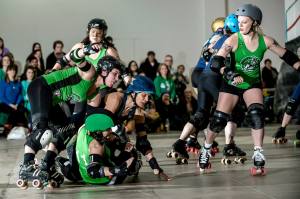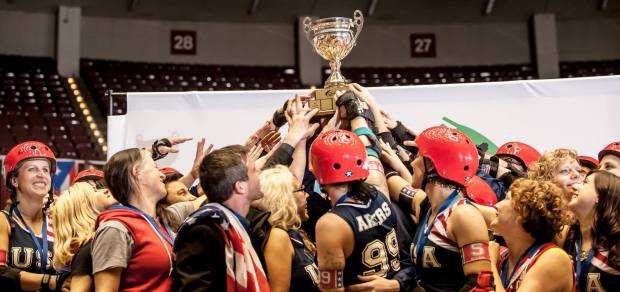
The Rideau Valley Vixens get lead jammer during their 224-139 semi-final win against Gold Coast at the 2014 WFTDA Division 2 playoffs. (Photo by Joe Mac)
It’s March 2013, at The Bunker in Toronto, Ontario, Canada, and the Rideau Valley Vixens are playing the hosts, Toronto’s CN Power, in the final game of the annual Quad City Chaos tournament. This is the fifth game between the two teams in three years, in what would have been a burgeoning rivalry had the games not all been so one-sided: Toronto had won all previous meetings by an average differential of 126 points.
There is under four minutes left on the clock and though Toronto has not run away with it as they have in previous bouts, they are up by 19 points and have led for the vast majority of the game. The Vixens have stuck with a very tight jammer rotation all weekend, barely veering from it, but suddenly Coach Adam Tasanko taps his blocker Jessica Kuehl on the helmet and hands her the star. A versatile skater, she has not jammed all game, rarely ever for the Vixens at this point, but it hardly seems to matter when the whistle blows. Lock down defense, physical jamming, 20 points and 90 seconds later and the Vixens have the lead. On another Coach’s hunch, a second blocker, Sister Disaster, is then sent out with the star to close out the game. She picks up lead and the Vixens hold on to win by 13 in what at the time would be characterized as the biggest upset in Canadian roller derby history.
While that win did not directly lead to the Vixens’ place in the 2014 WFTDA Division 2 Championship game (they didn’t even make the D2 playoffs in 2013), it was a definite and noticeable turning point. From that moment on, the team—from its long-serving and well-respected coach to its core of veteran and well-respected blockers—began to carry itself with a little more confidence, even a hint of swagger. An attitude well-earned, as it’s been a long road for the Vixens; full of obstacles and potholes, peaks and valleys, including its fair share of strife and heartbreak. But then, isn’t that what champions are made of?
In The Beginning
Roller derby is a pretty big deal in Ottawa. Despite its relatively small size (just under a million people), outside of Greater Toronto and British Columbia’s Lower Mainland, there is no region in the nation that has more active roller derby players than Canada’s capital. Spread out over three senior women’s leagues, a men’s team and a burgeoning junior program, during the spring and summer months, it’s easy to catch roller derby every weekend in the city. And while having multiple leagues is not generally conducive to on-track success (for every distinct roller derby league in a city there is probably at least one melodramatic email chain and a string of broken hearts to go with it), the Vixens have (eventually) made it work.
Roller derby in Ottawa began in late 2007, and the roots of the Vixens can be traced all the way back to a meeting at the Babylon, a hard-to-define nightclub/dive bar on Bank St. It was there that the first meeting of Ottawa Roller Derby (ORD) took place. Founded by Kelly McAlear (AKA: Honey Bee), within months the league had a team, the Bytown Blackhearts, and had struck up an integral friendship with Montreal Roller Derby, who at the time was the closest league to Ottawa.
By April 2008, the team was set to debut at the Montreal’s inaugural Beast of the East, a tournament featuring the fifteen house league teams in Ontario and Quebec at the time and filled out by Queen City’s Devil Dollies out of Buffalo. Now seen as a seminal event in the development of roller derby in the country, it would be baptism by fire for the Blackhearts who were drawn to face off against one of the co-hosts, Montreal’s La Racaille, in the opener. They would lose 65-29, but for a roster that contained many of the key early league stalwarts, including current Vixens members Hannah Murphy, Sister Disaster and Drunky Brewster, it sparked in them a lifelong love of the sport.
The Blackhearts had more success later that summer at the Virgin Suicides Brawl, a Toronto-based tournament hosted by the Greater Toronto Area Rollergirls and designed to feature new teams and inexperienced skaters (that has since been rebranded as the Fresh and the Furious). Advancing to the final, Ottawa squared off against Hammer City’s Death Row Dames and after a tense last jam, appeared to have won the tournament, only to have the win stricken down after a recounting of the scores. They lost by a single point.
Both of these early performances proved to be incredibly important team-building trips for the young team, and provided essential foundational development for the skaters. However, despite the on-track success, behind the scenes, things were tense at Ottawa Roller Derby. The early days of new roller derby leagues, existing as they do in a sport that especially in 2008 lacked consistent and reliable organizational precedents, can be tumultuous at times and there were rifts forming in the new league. Citing disagreements in organization (single-owner business vs. non profit) and competitive direction, in the fall of 2008, the Bytown Blackhearts walked away from Ottawa Roller Derby and established itself as an independent, not-for-profit roller derby team.
Roller Derby Returns to Ottawa
In a 2010 interview, Jerry Seltzer told the story of roller derby’s first foray into Ottawa in 1961. Only two years removed from taking over the reigns of roller derby from his father Leo, Jerry ventured north of the border in the winter of that year. He joked that it was on that trip that the first ever flat track game was played when the truck carrying the banked track froze in Sudbury and didn’t make it to Ottawa in time.
On January 31st, 2009, the first modern game of women’s flat track roller derby would be played in Ottawa, a full 48 years after the sport had first passed through the city. On that day, in front of a sold-out crowd, the newly independent Blackhearts would host Montreal’s very strong B-travel team, Les Sexpos, with a roster featuring some of the key figures in the eventual founding and development of Rideau Valley: DDT, Soul Rekker, Blackout Susan, Scotch Minx and Screaming Meanie Massacre all helped round out the roster that would lose that first game, 108-65. It proved a valuable learning experience, and when the team travelled to Vermont to play Green Mountain the following week, they won narrowly 136-131.
 As winter 2009 played out and the Blackhearts were preparing to return to Montreal for the second annual Beast of the East tournament, further strain and disagreements with ORD forced the Blackhearts to abandon their name. However, they were able to keep the logo and, undaunted, pushed forward. Within weeks a new league was born, the Rideau Valley Roller Girls, featuring the old Blackhearts logo: a roller girl with one hand on a cocked hip and the other thrusting a still-beating heart into the air—and its first team was named: The Slaughter Daughters.
As winter 2009 played out and the Blackhearts were preparing to return to Montreal for the second annual Beast of the East tournament, further strain and disagreements with ORD forced the Blackhearts to abandon their name. However, they were able to keep the logo and, undaunted, pushed forward. Within weeks a new league was born, the Rideau Valley Roller Girls, featuring the old Blackhearts logo: a roller girl with one hand on a cocked hip and the other thrusting a still-beating heart into the air—and its first team was named: The Slaughter Daughters.
Entering the Beast of the East in 2009, most eyes were on Montreal and Hammer City, the two leagues that had dominated the earliest days of Canadian Roller Derby, but three years in, the Canadian roller derby landscape had changed considerably at this point and the tournament also featured hopeful and up-and-coming leagues from Tri-City (Kitchener-Waterloo) and London, Ontario.
While ORD’s new team Capital Carnage would get eliminated early, the Slaughter Daughters would go on to be the breakout team of the tournament, trouncing Tri-City’s Venus Fly Tramps and Forest City’s Thames Fatales before taking Montreal’s heavily favoured (and eventual finalists) Les Contrabanditas to the limit in a three-point quarterfinal loss.
It would be a launching point for the new league and within months they’d named a second house league team (the Riot Squad) and began talks to form a distinct travel team, one that could play against the newly formed travel teams in Hammer City, Montreal and Toronto.
The Vixens Come out to Play
It was snowing heavily in Toronto on February 27th, 2010, but nonetheless, ToRD’s venue at the time, The Hangar, was packed for the team’s first game of the new season. Toronto’s CN Power was preparing for a big year, and to kick things off, they were facing the newest team on Canada’s competitive travel team circuit: The Rideau Valley Vixens. The Vixens were overwhelmed on that night against their big sisters from Toronto, getting beaten 199-49; nonetheless, the game represented a new era for roller derby in Ottawa and momentum would only build from there, even while yet another league, Capital City Derby Dolls, formed in the city.
For virtually the next two years the Vixens would slog it out primarily on the road, and between one-sided losses to vastly more experienced Canadian travel teams, they would gain hard-earned road victories against WFTDA B-teams and smaller US leagues like Ithaca, Central New York, and Morristown. It was a tough, hard road that every aspiring WFTDA team goes through early on. While some never make it out, many eventually learn to thrive on the adversity and the travel. The Vixens persevered.
In June 2012, two years after the team’s debut, the Vixens would play their first WFTDA-sanctioned game on the road against Central New York. It would be a narrow loss–9 points–but would typify some of the consistency problems that the team would have in its early days in the Association (they had defeated CNY only a year before). For example, the Vixens would crush Buffalo’s Queen City by 89 points, only to turn around and lose by virtually the same score to the same team five months later. Or the 2013 upset win over CN Power would be followed by a smothering loss to the less talented New Hampshire Roller Derby.
In all, the Vixens would play thirteen games in 2013, going 7-6 for the season (6-6 in sanctioned Play) finishing 68th in the WFTDA and just outside of the Division 2 playoffs. But there was undeniably a new, single-minded competitive focus on the team and in the league, starting with the desire for many of the skaters to begin playing under their real names (at least at the WFTDA level) and the formation of a B-level travel team (the Sirens) that would become a key breeding ground for future Vixens. Similarly, in the 2013 off-season a new home team would be formed (The Prime Sinisters) and all three rosters would be shaken up to help create parity at the house league level in hopes of raising the league’s competitive level as a whole.
The Vixens began the 2014 season with a pre-season, non-sanctioned game against Alliston, Ontario’s, Misfit Militia, largely considered Canada’s top non-WFTDA team, and they’d win the scrappy affair, kicking off a five-game WFTDA winning streak that would see them solidify their Division 2 Playoff spot. They’d end up 7-1 on the season (6-1 in sanctioned play to improve 21 spots in the ranking to 47th) with only a late-season upset loss to Calgary spoiling their perfect record—but the loss provided a healthy late-season shot in the arm to refocus them for the playoffs.
The team was drawn to play in the Kitchener-Waterloo D-2 tournament, and in August became the first Canadian team to play a WFTDA playoff game on home soil. And they did not disappoint.
In one of the closest playoff tournaments in the WFTDA’s history, the Rideau Valley Vixens would be the outliers, dominating their quarterfinal and semifinal games (the 89 and 105 point differentials were the two largest of the tournament—only two other games all weekend had differentials higher than 50). When they squared off against Bear City Roller Derby’s Berlin Bombshells in the final, they would be part of history as one half of the first ever all-international WFTDA tournament final. It would, of course, go down as one of the great tournament finals in history as well, when the Vixens were able to hold on to a narrow lead in a frantic and thrilling last jam, getting outscored 20-18, but holding on for the three-point win and a berth in the Division 2 final against the legendary Detroit Derby Girls.
To Nashville and Beyond!
In 2014 the Rideau Valley Roller Girls have emerged from a potentially fractious Ottawa flat track scene to become one of the nation’s most competitive and successful leagues.
They currently have five skaters on Team Ontario (Murphy, Bottema, Margaret Choke, Soul Rekker and Sister Disaster—not to mention that Brennan, H.P. Lovecrash, and Melanie Austin are alternates); also, Soul Rekker and Murphy have both been on the national squad since 2011. In 2014, the league had its first house league regular season and championship (won by the Prime Sinisters), while its B-team continued to develop and extended its travel to outside of Canada (into Ohio and New York State). This all coming off of the Slaughter Daughters’ three-year run as the top house league team in the Canadian derbyverse, a run that included three straight appearances in the Beast of the East final, two of which they won. And now, of course, they have qualified for the WFTDA D2 championship game.
This Vixen’s roster is one that is built to win, and built to win now. They play a short bench relying on a few carefully crafted lines, and stick to tight jammer rotations. For example, in their playoff tournament, the team travelled with only 12 skaters, three who exclusively jammed. Of the nine remaining, seven of them played between 46% and 60% of the total jams in the tournament: basically two lines in an on-off rotation. Aside from a few star passes, their three primary jammers (Soul Rekker, Shania Pain, and Melanie Austin[Tatious]) jammed all but one of the team’s total jams on the weekend. All three of the jammers had strong weekends with Rekker scoring 345 points (second at the tournament) on 6.5 points per jam and a 66% lead percentage (both of which were tops on the weekend). Shania Pain finished fifth in scoring and recorded a 56% lead percentage. AustinTatious also cracked 50% (51.3%) and averaged a solid 42 points per game.
The roster is a strong mix of homegrown talent and well-integrated transfers. Four members of the charter (Murphy, Sister Disaster, Soul Rekker, and Da Big Block) remain from the Vixen’s very first game in Toronto in 2010, while another, Drunky Brewster, has become the bench manager. The team also features other homegrown talent in blockers (including Margaret Choke, Jane Rudolph, and Bottema) and jammers (AustinTatious). But some transfers are key as well. It’s been a few years since Brennan joined the league from Gainesville, Florida, while BlackeyE seems to have finally found a perfect fit after stints in Kingston and Toronto. Perhaps the biggest addition of the season has been jammer Shania Pain. Originally having learned her derby in the Yukon, Pain just completed her first season with the Vixens despite the challenge of studying in Saint John, New Brunswick, for the vast majority of the year. Although she missed a few games this season, she was incredibly impactful when present.
In Nashville on Sunday, November 1, 2014, the Rideau Valley Vixens will make history when they face off against Detroit for the D2 championship: it will be the first time that an international team will compete for a WFTDA title. Detroit will pose the biggest challenge that the team will have faced this season.
On a post on the Rideau Valley Roller Girls website after the tournament win in Kitchener-Waterloo, Coach Adam cited the biggest strength of the team as being their mental game, which has grown noticeably over the past few seasons: “I am beyond impressed with the mental fortitude and focus the team displayed,” he said. “We upped our mental game ten-fold and avoided every possible meltdown on the bench and on the track.”
It is true that there is something different about this Vixens team. You can see it in the focus of their gazes. It is the look of a team that has confidence in themselves and each other. It is the look of a team that is unified in its single-minded determination to win.
It has been a long, challenging road for the Rideau Valley Roller Girls and their Vixens, and even though it’s just one stop of many on a road that will continue long after this season, this particular one in Nashville has all the feel of being a bigger stop than most.
**Read the Nerd’s recap of Rideau Valley’s Division 2 tournament win here.















































